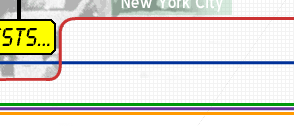



The Political Tool || Westway || The Stencilling Project || Carmageddon || Critical Mass || Critical Mass 10/31/00 || Fight for Oil
Westway: The End of The Road
A Lesson in Urban Environmental Activism
By A. Cortes
In New York City, nothing is certain except concrete. While this is known to those who live here, the constant barrage of auto build-up makes it almost impossible to imagine that there is any ecosystem in Manhattan left worth saving.
Cities become the first targets of smog-induced environmental decay; but it is this very buildup of dense infrastructure -- roads, cars, factories, buildings -- that create an urgent need for a more delicately balanced "urban ecosystem" Trees are needed to provide oxygen and combat the rising effects of ashtma. The water surrounding the island must be maintained to at least support aquatic life.
These values are easily lost in the density and needs of a rapidly expanding urban center. Take for instance, the case of Westway -- and of the devoted environmentalists that worked to save it.
Westway, the proposed $2 billion dollar highway planned for Manhattan's lower West side, was hailed as a solution to the buildup of traffic in and around Manhattan. By the end of the 1970's, Westway came close to being a reality. Backed by the government and powerful New York political, national, and big business interests, Westway was to take over five miles of prime Hudson riverfront property, running over four lanes of heavy duty traffic in and around the most valuable and fragile ecosystem on the island of Manhattan. The Hudson River, the thirty third most polluted river in the U.S., has been ravaged for decades by corporate monoliths such as General Electric, who have been dumping contaminates such as PCB's (polychlorinated biphenyls) inot the river for the past thirty years.
Frantically working to prove that Westway would alter the Hudson River ecosystem for the worse, and inevitably cause more health risks and traffic congestion problems than many New Yorkers bargained for, activist groups handed out flyers, signed petitions, and attended city council meetings. The campaign to end Westway managed to generate enough media attention; However, it could not completely halt the planned development of the area. Marcy Benstock, founder and president of the Clean Air Campaign (and itŐs sole employee), knew she needed more than the average gamut of environmentalist actions to end Westway development.
When the Army Corps of Engineers discovered that the Westway project could doom a certain species of fish -- the Atlantic (?) striped bass -- Marcy Benstock saw her opportunity and brought the issue to court. More studies were done, assessment teams were called in, and the project was delayed another three years. In the interim, Benstock gathered as much public attention to the cause as she could. The final decision was made, and it was concluded that the Westway project would irreparably damage the continuation of that particular species of fish. The judge ordered a complete halt of all Westway building activities, and by then Congress had shifted to other plans of national development investment interests.
The Westway plan was defeated by the ardent dedication and actions of these environmentalists. Benstock and her group were able to this by researching the area and constantly finding new developments. Their approach to make the public aware of the possible ramifications of a superhighway on the west side of New York City included a media-savy, newspaper-friendly approach that eventually caught the attention of powerful environmental lobbyists and organizations, willing to donate more time and resources to the campaign. Most importantly, Benstock knew that the only way to bring down the Westway "system" was through legal and court battles. And the future of the striped bass was her most staunch ally, proving that there still are areas in Manhattan left to protect. The next step, of course, ifs finding those who are willing to protect it.
Back to top